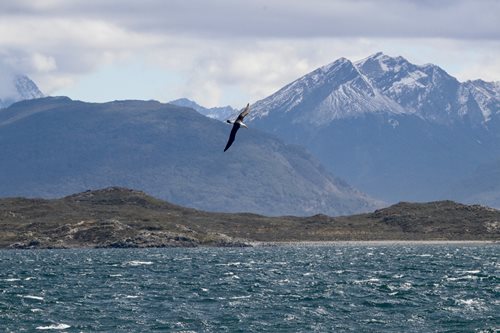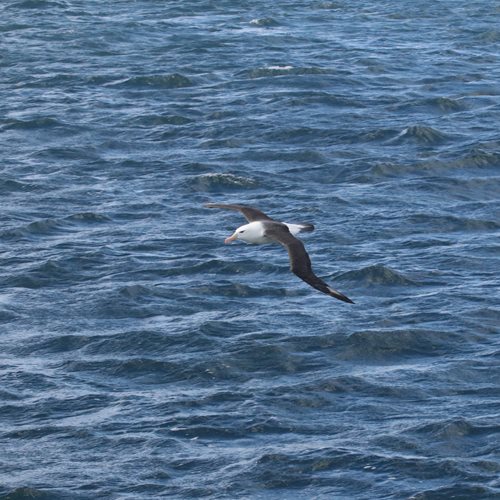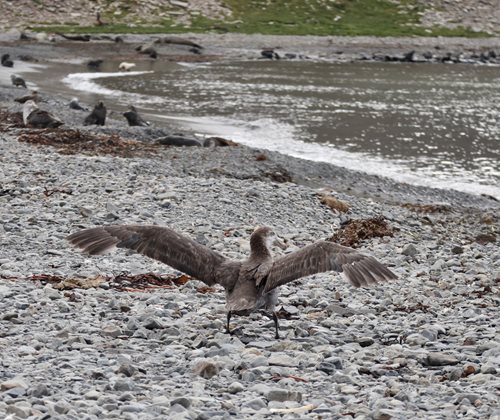She came gliding by in perfect control, graceful, slender, black wing-tips not quite touching the swell. She effortlessly banked so I could see the slight frown across her snow-white head. She tipped her black wings again to accelerate ahead of the ship. Then another, stockier, bird swept in, also with the tube nose of the albatross family, a drip of salt water on its beak-tip. This one was grey and looked less pristine and too solid to be a petrel but petrel it was.
Then against a sapphire sea and cloudless skies, another albatross joined us. It seemed to have a shadow but the shadow turned into a smaller bird: maybe a cape petrel or a Wilson’s storm petrel. I was only just beginning to recognise the local celebrities.
We’d steamed out from Ushuaia across the Drake Passage which has the reputation for being one of the roughest stretches of sea in the world so we’d applied motion sickness patches. At first the sea was lapis blue, then it turned a wonderful deep emerald green, the sky became slate grey and our little ship bravely plunged ahead full steam for three days as we ‘explorers’ clung on and discussed sea sickness remedies. Some were confined to their cabins.
We were told we were on an expedition, in the true spirit of the early Antarctic explorers but the trip made me think again about what kind of trip should be called an expedition. I’ve been on a few adventures to very remote corners of the globe and a couple of years back, I gave a talk at the Cambridge University Exploration Society. As so often happens at such events, people are keen to share their own tales of intrepid exploits and a young woman came up to tell me about her expedition to Ladakh at the western end of the Himalayas. She broke off from her rather dull account to say, ‘Oh-My-God, you’ll find it hard to believe but I didn’t have a phone signal for ten days!’ I couldn’t think how to respond. I didn’t tell her that the first time I visited Nepal, making a phone call involved taking an eight-hour bus ride, going to the central Post Office in Kathmandu, booking a call and only then, after two hours, could I speak to my folks back home.
S and I signed up for an ‘expedition’ this spring, paying shed-loads of money to cross the Antarctic circle and set foot on the Antarctic peninsula. We were, apparently, following in the footsteps of Scott and Shackleton. We learned of the demise of Scott’s team (who ran out of food but were still valiantly carrying 20kg of fossils). We learned of Shackleton’s men left on a wave-lashed pebble beach on Elephant Island. They too ran out of food and the local penguins and fur seals had gone back to sea. The starving men had planned to eat the least popular team member when rescue arrived after 137 days. Meanwhile we ate sumptuous breakfasts, three-course lunches and dinners, with afternoon tea and cakes and cocktails to stave off huger in between meals.
We weren’t explorers and we weren’t on an expedition but we had been transported into the wonderful Southern Ocean, home to growlers and humpbacks and penguins and crab-eaters and skuas and orcas.
 |
Black-browed albatross gracefully quartering the seas close to Ushuaia in
Argentinian Patagonia |
 |
| The most beautiful of the albatross family |
 |
| Giant petrel at Stromness on South Georgia by Simon Howarth. You might be able to make out the saline drip in its beak, their way of excreting excess salt |
A second Antarctic blog is here
Anardica